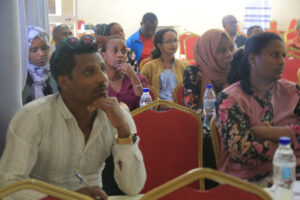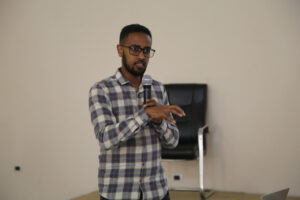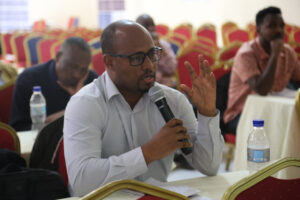AHRI’s researchers as part of the wider CEBHA+ consortium, share their findings on research tasks related to cardiovascular diseases.
The dissemination workshop which took place in Adama, on March 1, brought together health professionals and pertinent stakeholders, who played an integral role to the success of the project.


During the workshop, an overview of the CEBHA+ was shared including the key components of the consortium which includes: Research, Capacity Development, Integrated Knowledge Translation.
 Of the various research tasks, CEBHA+ Project Coordinator, Kiya Kedir, whilst sharing the CEBHA+ Task 1.2 study titled, ‘CVD risk perception and communication strategy among urban and rural communities in Ethiopia’, indicated that the cardiovascular disease burden in Ethiopia has been on a rise, compounded by rapid urbanization, a shift in diet, excessive tobacco use; harmful use of alcohol and physical inactivity.
Of the various research tasks, CEBHA+ Project Coordinator, Kiya Kedir, whilst sharing the CEBHA+ Task 1.2 study titled, ‘CVD risk perception and communication strategy among urban and rural communities in Ethiopia’, indicated that the cardiovascular disease burden in Ethiopia has been on a rise, compounded by rapid urbanization, a shift in diet, excessive tobacco use; harmful use of alcohol and physical inactivity.
From the study which sought to explore CVDs risk perception, risk communication, and health seeking intentions of residents of rural and urban communities in Ethiopia, Kiya elaborated the following as key findings from the study.
- Participants’ awareness towards CVD was found to be poor mainly in rural settings.
- There was existence of cultural perception that CVD is untreatable owing to inaccessibility of care and the common belief that it ‘is the will of God’.
- Community perception of CVD risk is low, despite beliefs that the risk factors are common particularly in urban setting.
- Participants, especially among urban settings preferred the use of visual aids and colours to communicate risk.
- How and by whom the risk message was communicated impacted message acceptance.
“In general this study showed there is a need to increase the level of awareness and perception towards NCD and CVD in particular among urban and especially rural participants in Ethiopia,” sensitized Kiya whilst highlighting the implications of the study.
Recommendations were also put forth from the study on the need to strengthen educational programs targeting NCDs/CVDs.
 As part of the results dissemination for the CEBHA+ Task 1.3 study, Researcher Firaol Mesfin, through his presentation, titled, ‘Health extension worker mediation CVD risk screening and referral for care at the community level in Ethiopia’, cited that pilot studies in resources limited countries have over the years utilized community level screening by community health workers.
As part of the results dissemination for the CEBHA+ Task 1.3 study, Researcher Firaol Mesfin, through his presentation, titled, ‘Health extension worker mediation CVD risk screening and referral for care at the community level in Ethiopia’, cited that pilot studies in resources limited countries have over the years utilized community level screening by community health workers.
Firaol indicated that the study was set out with the aim to pilot a health extension worker mediated CVD risk screening study in multiple urban and rural community settings. As he explained, multiple kebeles in Adama and rural regions around Adama were selected including recruitment of 10 health extension workers and 1000 participants.
From the pilot study, the following were listed as key observations;
- The 10-year CVD risk as well as undiagnosed hypertension in both urban and rural settings were found to be consistent with previous results in Ethiopia
- There were differences between urban and rural sites in prevalence of risk factors.
- There were high overall rates of referral under the pilot program, with notable higher rates among rural areas as compared to urban populations.
- Among urban dwellers, the highest rates of referral were among those with a prior history of hypertension and/or diabetes.
- The most common reason for lack of attendance included; inconvenience, feeling well and financial constraints.
- BMI based CVD risk equation was noted to be accurate in predicting CVD risk compared with cholesterol.
“Following completion of the study, we re-analyzed our data in STEPS and observed that waist circumference showed 98% concordance with BMI, which potentially maybe used in facilitating community screening in the future,” explained Firaol, whilst showcasing how waist circumference may be used in future to facilitate door to door screening.
Following the presentations, two way discussions were had with suggestions on way forwards from the project.


